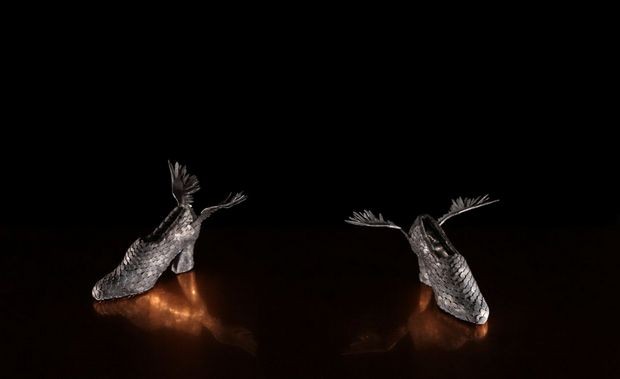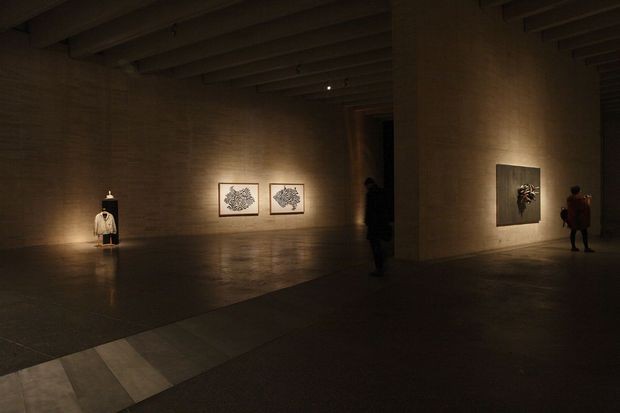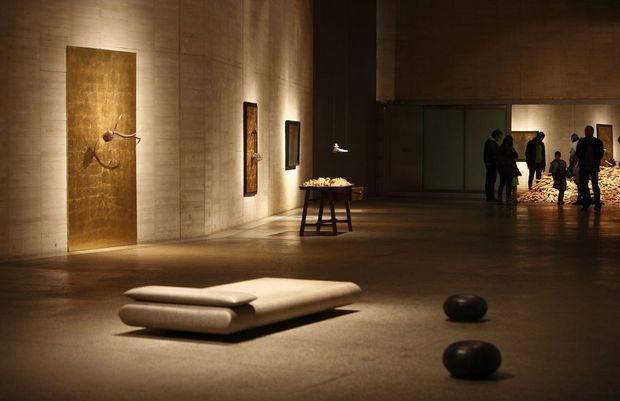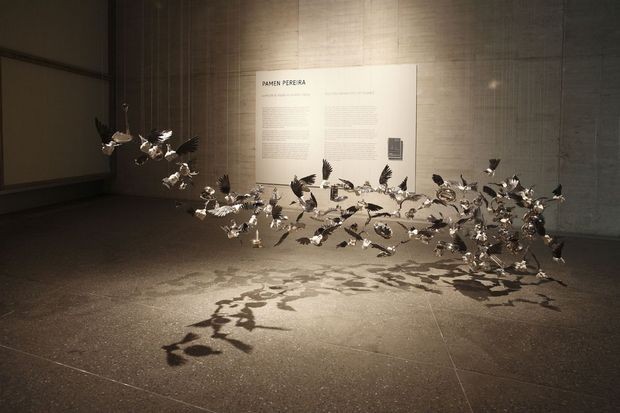The Stone Woman Gets Up to Dance
Pamen Pereira
20 Feb - 04 Sep 2016
THE STONE WOMAN GETS UP TO DANCE
Pamen Pereira
20 February - 4 September 2016
The Zen master Tozan wrote the Hokyo zan mai (Precious Mirror Samadhi) in the 9th century, inciting his disciples to look within themselves, not at others, and liberate their minds from all illusory thoughts and concepts. The precious mirror reflects all those phenomena of the cosmos that appear and disappear freely; while the samadhi –a Sanskrit term to refer to the practice that leads to complete meditation– is the awakening of the mind towards illumination.
The work of Pamen Pereira is a continuous search towards this state of enlightenment. A regular practitioner of Zen, the years she spent in Japan and her constant travels have been essential in shaping her artistic practice. As in Japanese aesthetics, she seeks life’s meaning through a poetic impulse in art where upon organizing chaos, beauty and harmony surge forth. Her works usually find beauty with nature, using it as raw material and transforming it into poetic, mysterious images. This process of transformation is like a journey into her own depths –a journey like the creative act itself where internalization, learning and exteriorization of new experiences ignite the senses.
The exhibition The Stone Woman Gets Up to Dance gathers several works of Pamen Pereira from the 1990s to the present, together with works of recent production. In these works, the facet of the artist-alchemist is portrayed, as can be seen in her manipulation of different materials and media. Thus, earth, air, water and fire are converted into poetic objects that form a vital cycle within a space with a ritualistic atmosphere. In the same way that a scientist works with matter, an artist works with emotions. Her matter is the basic elements of life combined with imagination, putting into practice Gaston Bachelard’s notion of “material imagination”; and her emotions are brought about by memory, curiosity and instinct. The union of both leads her to create works inspired by the sturm und drang (storm and stress) movement, where the “storm” gives emphasis to the sublime power of nature as source of inspiration, and “stress” refers to the role of emotions or the will to express confusion present in nature.
In this way, the artist searches for unity between matter and spirit following Eastern philosophy, where the contemplation of, and communion with nature become predominant by means of internal adhesion or intuition, in a narration of the interior pulsations from the beating of her heart, her roots, travels, readings and passions.
The exhibition adopts a mise en scène where shadows highlight the beauty of the works. In the first space, we find works that the surrealists define as object-poems –where the juxtaposition of elements convert the invisible into matter, weight to soar, or that which is buried to be unearthed. The artist starts her state of meditation in her Lecho de piedra (2001), the inert comes to life and around her metal levitates, bones are unearthed and rooted temples soar up to the sky. The elements are fused by imposible encounters in El caballo blanco penetra la flor de la caña (2012) where a deer’s antlers and a palm flower are joined as if it were their natural, inevitable destiny; or the two roots of El sumo sacerdote (2010), find a symbolic union that in the world of the tarot refers to the “real journey” —a journey symbolized by the golden shoes in Sin título (2000).
Nature is the raw material and the subject of representation in many of Pereira’s works, and the creative or thought process is perhaps more important to her than the final object. In this light, elements from the artist’s studio are a testament to this process. Gabinete de trabajo (1998) is a desk which supports a landscape of mountain ranges made from grease. These mountain ranges are reminiscent of Buddhist pilgrimages where a retreat to those areas is a means of understanding one’s self and our relation to the world, and are also represented in the series of “smoke paintings”.
A huge installation occupies the second hall where a group of swallows carry some furniture into the air to the rhythm of the beat of Voz primal (2015), whose throbbing flame condenses matter and energy, like the origin of the whole universe. This internal beating is what makes the artist face and understand the power of nature because just like in the chinese painting tradition, an artist cannot represent it without a thorough observation and dominion of the exterior world. Thus, El mundo entero es medicina (2010) draws a dependent relationship of the whole with the parts and the parts with the whole, following this spiritual journey to the summit of Vista isométrica del continente antártico desde el Mar de Ross (2006) o El curso circular de la luz II (2005), works done with smoke on velvet and whose processes are directly related to Chaqueta de trabajo (2000) and Ecuanimidad (2015). As such, these works are bearers of time, memories or stories that gain a life of their own and are the material evidence of this spiritual search –a search that leads her to the Erhabenen (the sublime), a Kantian concept that describes extreme ecstasy that transcends the rational.
Pamen Pereira’s cosmos ends in the altar of Tampoco el mar duerme (2015), a storm which she tries to trap and contain, feeding from its vital energy; in the same way that she tries to condense all the love in Ramón Pereira, el sol es una estrella (2003-04). The beauty in the imperfection of this found object sums up the wabi sabi aesthetics of the Buddhist Mahāyāna philosophy and represents liberation and transcendence. Protected by La mujer de agua sigue cantando (2015) as if they were two temple dragons. The works in the exhibition condense air, water and fire –the four elements of life— that together with a fifth element —Mu (emptiness) and the principle of yin-yang—, constitute a place where transformations happen and true plenitude can be reached.
Through emptiness, the heart becomes the mirror of itself of the world. And before this mirror, the wood man sings, the stone woman gets up to dance and, in the words of Dokushô Villalba, “the four elements of the phenomenal life always end up returning to its origin —the essential emptiness— like children returning to their mothers, or like the rivers returning to the ocean.”
Pamen Pereira
20 February - 4 September 2016
The Zen master Tozan wrote the Hokyo zan mai (Precious Mirror Samadhi) in the 9th century, inciting his disciples to look within themselves, not at others, and liberate their minds from all illusory thoughts and concepts. The precious mirror reflects all those phenomena of the cosmos that appear and disappear freely; while the samadhi –a Sanskrit term to refer to the practice that leads to complete meditation– is the awakening of the mind towards illumination.
The work of Pamen Pereira is a continuous search towards this state of enlightenment. A regular practitioner of Zen, the years she spent in Japan and her constant travels have been essential in shaping her artistic practice. As in Japanese aesthetics, she seeks life’s meaning through a poetic impulse in art where upon organizing chaos, beauty and harmony surge forth. Her works usually find beauty with nature, using it as raw material and transforming it into poetic, mysterious images. This process of transformation is like a journey into her own depths –a journey like the creative act itself where internalization, learning and exteriorization of new experiences ignite the senses.
The exhibition The Stone Woman Gets Up to Dance gathers several works of Pamen Pereira from the 1990s to the present, together with works of recent production. In these works, the facet of the artist-alchemist is portrayed, as can be seen in her manipulation of different materials and media. Thus, earth, air, water and fire are converted into poetic objects that form a vital cycle within a space with a ritualistic atmosphere. In the same way that a scientist works with matter, an artist works with emotions. Her matter is the basic elements of life combined with imagination, putting into practice Gaston Bachelard’s notion of “material imagination”; and her emotions are brought about by memory, curiosity and instinct. The union of both leads her to create works inspired by the sturm und drang (storm and stress) movement, where the “storm” gives emphasis to the sublime power of nature as source of inspiration, and “stress” refers to the role of emotions or the will to express confusion present in nature.
In this way, the artist searches for unity between matter and spirit following Eastern philosophy, where the contemplation of, and communion with nature become predominant by means of internal adhesion or intuition, in a narration of the interior pulsations from the beating of her heart, her roots, travels, readings and passions.
The exhibition adopts a mise en scène where shadows highlight the beauty of the works. In the first space, we find works that the surrealists define as object-poems –where the juxtaposition of elements convert the invisible into matter, weight to soar, or that which is buried to be unearthed. The artist starts her state of meditation in her Lecho de piedra (2001), the inert comes to life and around her metal levitates, bones are unearthed and rooted temples soar up to the sky. The elements are fused by imposible encounters in El caballo blanco penetra la flor de la caña (2012) where a deer’s antlers and a palm flower are joined as if it were their natural, inevitable destiny; or the two roots of El sumo sacerdote (2010), find a symbolic union that in the world of the tarot refers to the “real journey” —a journey symbolized by the golden shoes in Sin título (2000).
Nature is the raw material and the subject of representation in many of Pereira’s works, and the creative or thought process is perhaps more important to her than the final object. In this light, elements from the artist’s studio are a testament to this process. Gabinete de trabajo (1998) is a desk which supports a landscape of mountain ranges made from grease. These mountain ranges are reminiscent of Buddhist pilgrimages where a retreat to those areas is a means of understanding one’s self and our relation to the world, and are also represented in the series of “smoke paintings”.
A huge installation occupies the second hall where a group of swallows carry some furniture into the air to the rhythm of the beat of Voz primal (2015), whose throbbing flame condenses matter and energy, like the origin of the whole universe. This internal beating is what makes the artist face and understand the power of nature because just like in the chinese painting tradition, an artist cannot represent it without a thorough observation and dominion of the exterior world. Thus, El mundo entero es medicina (2010) draws a dependent relationship of the whole with the parts and the parts with the whole, following this spiritual journey to the summit of Vista isométrica del continente antártico desde el Mar de Ross (2006) o El curso circular de la luz II (2005), works done with smoke on velvet and whose processes are directly related to Chaqueta de trabajo (2000) and Ecuanimidad (2015). As such, these works are bearers of time, memories or stories that gain a life of their own and are the material evidence of this spiritual search –a search that leads her to the Erhabenen (the sublime), a Kantian concept that describes extreme ecstasy that transcends the rational.
Pamen Pereira’s cosmos ends in the altar of Tampoco el mar duerme (2015), a storm which she tries to trap and contain, feeding from its vital energy; in the same way that she tries to condense all the love in Ramón Pereira, el sol es una estrella (2003-04). The beauty in the imperfection of this found object sums up the wabi sabi aesthetics of the Buddhist Mahāyāna philosophy and represents liberation and transcendence. Protected by La mujer de agua sigue cantando (2015) as if they were two temple dragons. The works in the exhibition condense air, water and fire –the four elements of life— that together with a fifth element —Mu (emptiness) and the principle of yin-yang—, constitute a place where transformations happen and true plenitude can be reached.
Through emptiness, the heart becomes the mirror of itself of the world. And before this mirror, the wood man sings, the stone woman gets up to dance and, in the words of Dokushô Villalba, “the four elements of the phenomenal life always end up returning to its origin —the essential emptiness— like children returning to their mothers, or like the rivers returning to the ocean.”




